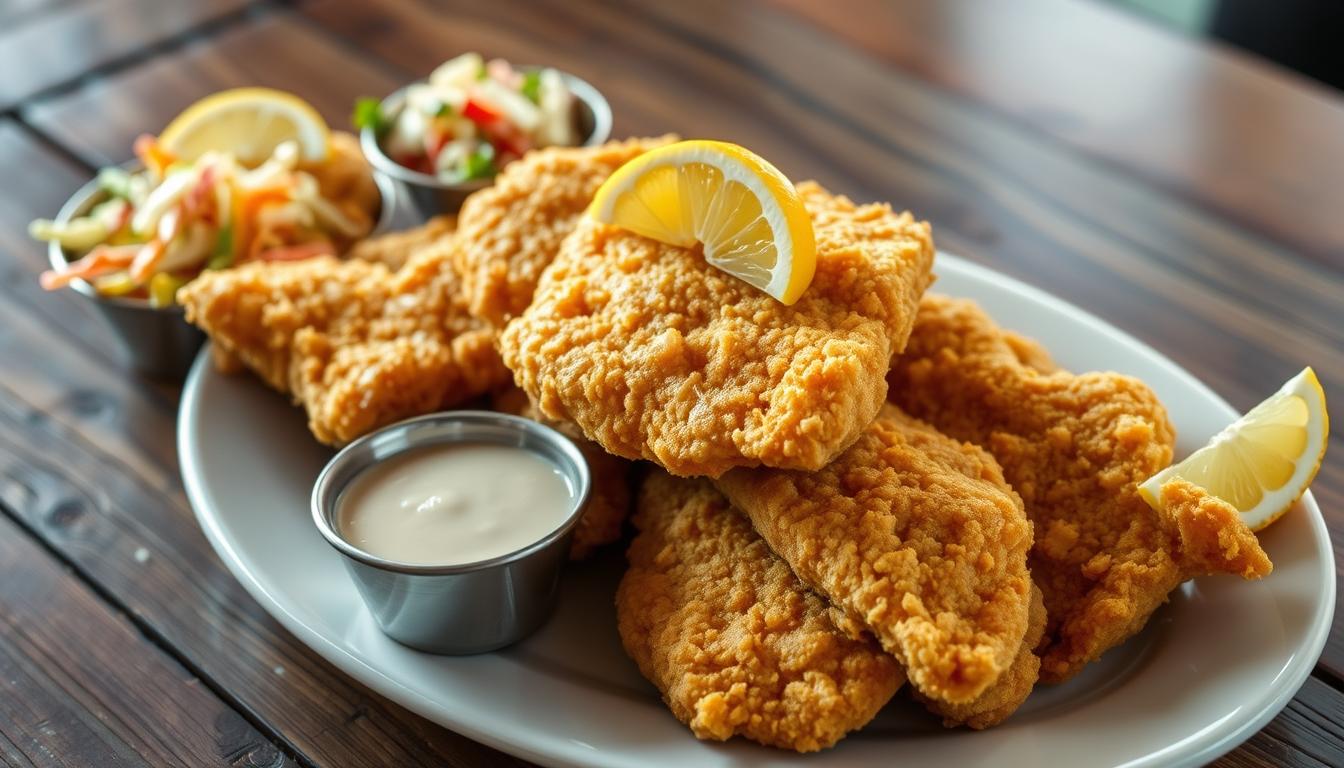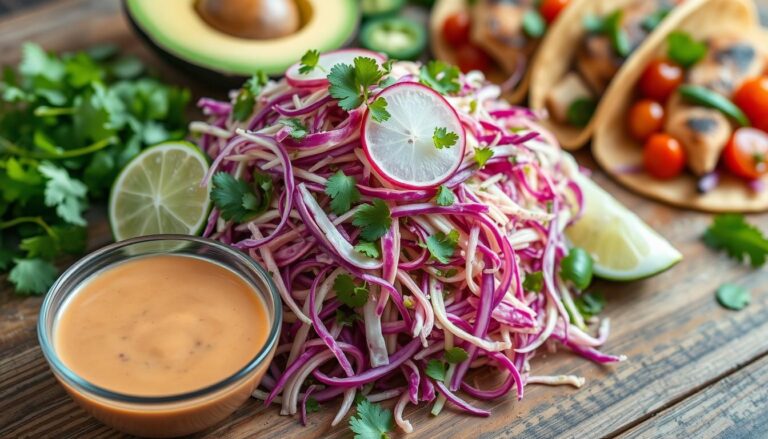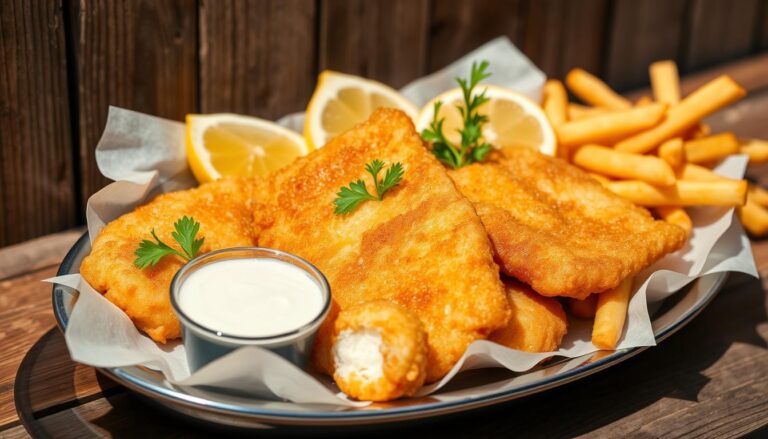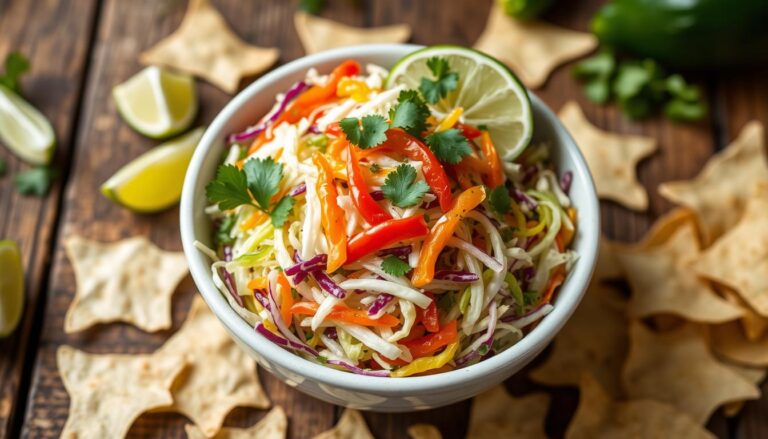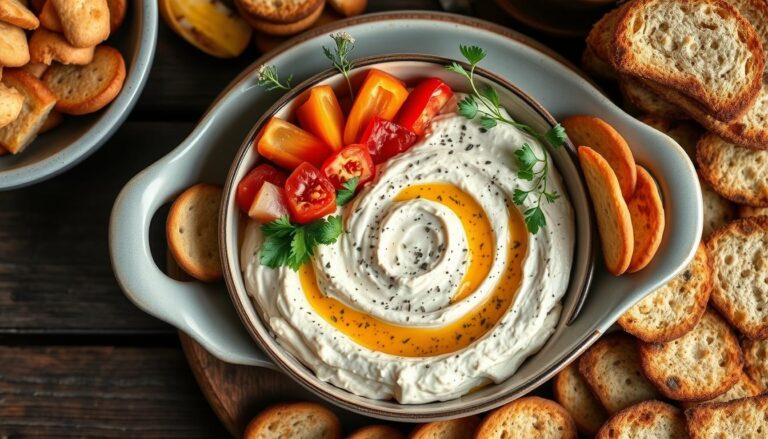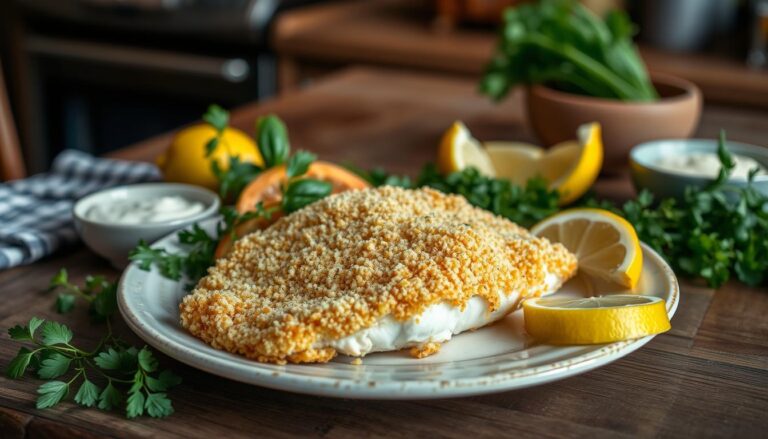Cornmeal Fried Fish: Irresistibly Crispy and Delicious
Growing up in Georgia’s coastal areas, I learned cornmeal fried fish is more than food. It’s a tradition passed down through generations. The sound of fish hitting hot oil and the golden crust are unforgettable. They tell a story of family, culture, and the South’s seafood heritage.
Southern seafood dishes are simple yet flavorful. Cornmeal fried fish is a perfect example. It turns fresh fish into crispy, delicious bites that excite your taste buds. This recipe offers a true taste of Southern cooking, whether you’re an experienced cook or just starting out.
Table of Contents
Key Takeaways
- Cornmeal creates the ultimate crispy fish coating
- Southern seafood traditions offer unique flavor profiles
- Proper oil temperature is crucial for perfect frying
- Fresh fish and seasoning make all the difference
- Cooking in batches ensures optimal crispiness
Why Cornmeal Makes the Perfect Fish Coating
Cornmeal is a superstar for making crispy fish coatings. It turns your fried fish recipe into a masterpiece. This magical ingredient adds unmatched texture and flavor.
Benefits of Using Cornmeal
Cornmeal offers many benefits for your crispy fish coating:
- Creates a golden-brown exterior that’s visually appealing
- Provides exceptional crunch and texture
- Adds subtle corn flavor to the fish
- Gluten-free alternative to traditional wheat flour
White vs. Yellow Cornmeal Differences
Knowing the difference between white and yellow cornmeal can improve your fried fish recipe:
| White Cornmeal | Yellow Cornmeal |
|---|---|
| Milder flavor | Stronger corn taste |
| Lighter color coating | Deeper golden hue |
| Delicate texture | More robust crunch |
Texture and Crunch Factor
The secret to a perfect crispy fish coating is cornmeal’s unique texture. Its coarse structure creates air pockets during frying. This results in a crunchy exterior that beats traditional coatings.
“Cornmeal isn’t just a coating—it’s a crispy transformation!” – Southern Cooking Enthusiasts
Choosing cornmeal for your fried fish recipe ensures a restaurant-quality crunch. It will wow your family and friends.
Essential Ingredients for Southern Fried Fish
To make the perfect fried fish fillet, you need the right mix of ingredients. Southern cooking uses simple, strong ingredients. These turn an ordinary fish into a dish you’ll remember.
For a true Southern-style dish, you’ll need:
- Fresh white fish fillets (catfish, snapper, or cod)
- Cornmeal for crispy coating
- All-purpose flour
- Cajun seasoning for extra kick
- Buttermilk for tenderizing
- Vegetable oil for frying
The secret to a great fried fish fillet is in the seasoning. Cajun seasoning adds depth and excitement. It creates a spicy crust that boosts the fish’s natural flavors.
| Ingredient | Quantity | Purpose |
|---|---|---|
| White Fish Fillets | 1 pound | Main protein |
| Cornmeal | 1/3 cup | Crispy coating |
| Cajun Seasoning | 1 tablespoon | Flavor enhancement |
| Buttermilk | 1 cup | Tenderizing marinade |
“The secret to Southern fried fish is in the seasoning and the technique.” – Southern Cooking Tradition
When picking your ingredients, freshness is key. Look for fish fillets that are firm, smell like the ocean, and are not discolored. Using high-quality ingredients will make every bite crispy and flavorful.
The Best Fish Varieties for Cornmeal Frying
Choosing the right fish is key to making your fry fish dish unforgettable. Not all fish are good for cornmeal frying. Knowing your options is crucial for success in the kitchen.
Top White Fish Choices
Some fish are better than others for cornmeal frying. Here are the top picks:
- Tilapia: A mild-flavored fish perfect for absorbing seasonings
- Catfish: Known for its robust flavor that pairs perfectly with cornmeal coating
- Alaskan cod: A restaurant favorite that holds up exceptionally well during frying
- Haddock: Another white fish with a delicate flavor profile
Freshness Indicators
Finding fresh fish is important for your dishes. Look for these signs:
- Clear, bright eyes
- Firm flesh that springs back when touched
- No strong fishy odor
- Bright, shiny skin
Size and Thickness Considerations
| Characteristic | Recommendation |
|---|---|
| Thickness | Less than 1.5 inches |
| Fillet Type | Boneless |
| Cooking Time | 3-5 minutes per batch |
“Choose fish fillets that are uniform in thickness to ensure even cooking and a perfectly crispy exterior.”
Avoid using dense fish like tuna or salmon. They dry out quickly and don’t get crispy. Stick to white-fleshed fish for the best results.
Seasoning Your Cornmeal Fish Coating
White fish is a blank slate for bold flavors. Your cornmeal coating is where the magic happens. The right mix of soul food classics and cajun seasoning can turn a simple dish into a masterpiece.
Creating the perfect seasoning blend is all about spice balance. A well-crafted cajun seasoning can take your fish from ordinary to extraordinary. Here are some key ingredients for your spice mix:
- 1 tablespoon onion powder
- 1 1/2 teaspoons garlic powder
- 1 1/2 teaspoons chipotle powder
- 1 1/2 teaspoons white pepper
When making your signature spice blend, remember that freshness matters. Dried herbs like dill and parsley lose flavor fast. So, replace them often to keep your dish tasting great.
“Seasoning is the soul of Southern cooking” – Southern Kitchen Wisdom
Use 3 tablespoons of seasoning per batch for 6 portions of fish. For a zesty twist, try a chile lime seasoning. Mix sea salt, chile pepper, and dried lime zest equally.
Your aim is to create a blend that enhances the fish’s flavor without overpowering it. Don’t be afraid to experiment and adjust until you find your perfect spice mix.
The Perfect Buttermilk Marinade Method
Buttermilk marinade is a beloved method in family recipes. It turns regular fish into a special dish. This Southern secret tenderizes fish and adds great flavor to your fried cornmeal dish.
Buttermilk marinade has many benefits for making tasty fried fish. Its acidity breaks down proteins, making the meat tender.
Why Buttermilk Works
Buttermilk has a special effect on fish. Its tangy nature:
- Tenderizes fish meat
- Enhances natural flavors
- Provides a smooth coating base
- Improves overall texture
Marinating Time Guidelines
Here are key times for your buttermilk marinade:
| Fish Type | Recommended Marination Time |
|---|---|
| Catfish Fillets | 8 hours |
| Thin White Fish | 30-60 minutes |
| Thick Fish Cuts | 2-4 hours |
Flavor Enhancement Tips
Make your buttermilk marinade better with these tips:
- Add 1/4 tsp hot sauce for subtle heat
- Include minced garlic
- Sprinkle dried herbs like thyme or parsley
- Experiment with ground black pepper
“A great marinade transforms good fish into an unforgettable meal.” – Southern Cooking Tradition
Remember, your buttermilk marinade is key to making crispy, flavorful fried fish. It will become a favorite in your family recipes.
Step-by-Step Cornmeal Fried Fish Preparation
Making a tasty fried fish recipe needs focus. Start by getting the right ingredients and following a clear method.
Ingredients Preparation
First, gather your main ingredients for the fried fish. You’ll need:
- 1-2 pounds of fresh fish (red snapper, catfish, or cod)
- 1/2 cup all-purpose flour
- 1/4 cup cornmeal (optional)
- Seasonings:
- 1 teaspoon salt
- 1/2 teaspoon black pepper
- 1/2 teaspoon paprika
- 1/2 teaspoon garlic powder
Coating and Preparation Technique
Getting the coating right is key for a crispy fried fish. Mix your dry ingredients well in a shallow dish. Dry your fish fillets before coating to get the best crispiness.
“The secret to perfect fried fish is in the coating and oil temperature” – Southern Cooking Tradition
Frying Process
For your fried fish, keep the oil at 350°F. Use oils like canola or peanut oil because they don’t smoke easily. Fry each side for 4-5 minutes until it’s golden brown.
| Frying Parameter | Recommended Setting |
|---|---|
| Oil Temperature | 350°F (175°C) |
| Oil Depth | 1/2 inch |
| Frying Time per Side | 4-5 minutes |
Pro Tip: Always let your fried fish rest on a wire rack to maintain its crispy texture.
Your cornmeal fried fish is now ready to be enjoyed with lemon wedges or your favorite sauce!
Deep Frying vs. Pan Frying Techniques
Choosing the right deep frying techniques can make or break your fried fish fillet. Understanding the differences between deep frying and pan frying is key. It helps home cooks make seafood dishes as good as those in restaurants, with perfect crispiness.
When making a delicious fried fish fillet, your cooking method matters a lot. It affects the flavor, texture, and quality of your dish. Different methods offer unique benefits that can improve your cooking.
Oil Temperature Control
Keeping the oil temperature just right is essential for great frying. Here are some important temperature guidelines:
- Deep frying: 350°F to 375°F (175°C to 190°C)
- Pan frying: 300°F to 350°F (150°C to 175°C)
- Ideal fish frying temperature: 375°F
Batch Sizing Tips
Getting the batch size right is important for even cooking and keeping the oil temperature steady. Here are some tips:
- Avoid overcrowding the cooking vessel
- Fry fish in small batches
- Maintain consistent oil temperature
Safety Measures
Staying safe while frying is crucial. Here are some important safety tips:
- Use long-handled utensils
- Wear protective kitchen gear
- Keep a fire extinguisher nearby
- Never leave hot oil unattended
“Mastering deep frying techniques transforms an ordinary fish fillet into a culinary masterpiece.” – Professional Chef
Try both deep frying and pan frying to find your favorite way to make crispy, golden-brown fried fish fillets. They will surely impress your family and friends.
Achieving the Perfect Golden-Brown Crust
Getting the crispy fish coating just right is all about precision and skill. The golden-brown crust is what makes a Southern-style seafood dish stand out. You want a crust that’s crispy on the outside and juicy on the inside, full of flavor.
- Maintain oil temperature at 370°F for optimal crispiness
- Cook fish in small batches to prevent overcrowding
- Flip fish only once during cooking
- Aim for a cooking time of 3-4 minutes per side
“The secret to a perfect golden crust is patience and temperature control” – Southern Cooking Wisdom
Here are the main techniques to focus on for your fried fish recipe:
- Ensure fish is thoroughly dried before coating
- Create a double-dredging method using flour, then egg wash, then cornmeal
- Use fresh oil heated to the correct temperature
| Coating Ingredient | Quantity | Purpose |
|---|---|---|
| Cornmeal | 2 cups | Creates crispy texture |
| All-purpose flour | 1 cup | Helps coating adhere |
| Cornstarch | 1/4 cup | Enhances crispiness |
Look for visual signs that your fish is done. It should turn golden-brown and float. When done right, your crispy fish coating will be light, crunchy, and incredibly tasty.
Traditional Southern Side Dishes
Enjoying cornmeal fried fish with the right side dishes makes it a true southern cuisine experience. Soul food classics enhance your crispy fish, making your meal unforgettable. It satisfies both your hunger and your love for tradition.
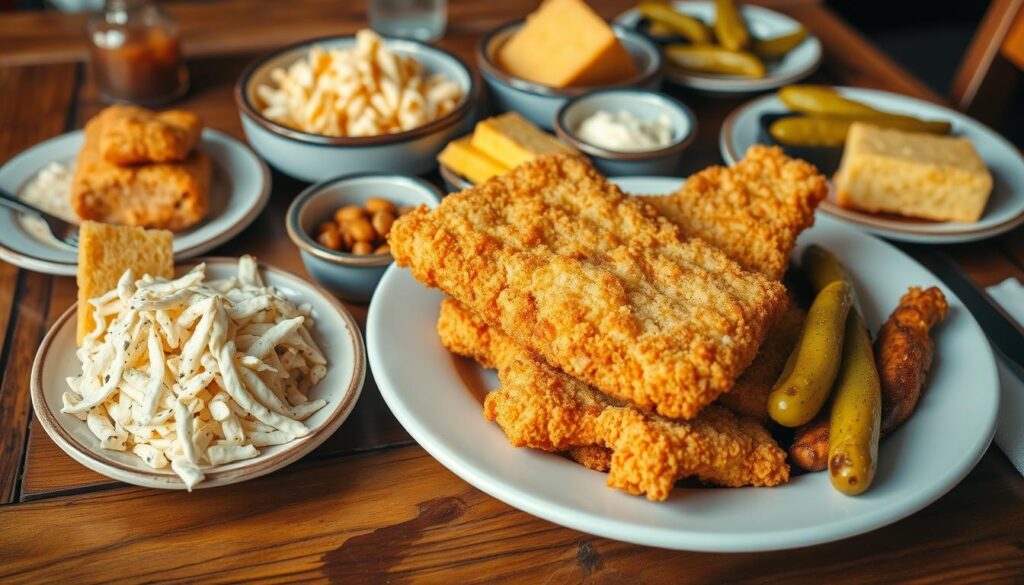
Your fried fish needs sides that match its crispy texture and rich flavor. The right side dishes turn a simple meal into a southern cooking celebration.
Classic Southern Pairings
- Crispy hush puppies
- Creamy coleslaw
- Baked beans
- Potato salad
- Pickled vegetables
Sauce Recommendations
No southern fried fish is complete without the right sauce. These sauces can take your flavor journey to the next level:
| Sauce | Flavor Profile |
|---|---|
| Homemade Tartar Sauce | Creamy, tangy, perfect for seafood |
| Remoulade | Spicy, zesty, adds complexity |
| Hot Sauce | Spicy kick, traditional southern touch |
Pair your cornmeal fried fish with these southern delights. You’ll connect with generations of culinary tradition. Bon appétit!
Common Frying Mistakes to Avoid
Getting good at deep frying fish fillets takes skill and precision. Many home cooks make simple mistakes that ruin their crispy fish dreams.
- Overcrowding the cooking pan, which drops oil temperature and creates soggy results
- Using oil that’s not at the correct temperature (350°F to 400°F)
- Failing to pat fish completely dry before coating
- Using stale or degraded cooking oil
Temperature control is crucial in deep frying techniques. The ideal oil temperature should stay between 375°F and 400°F. If it drops, your fish will soak up too much oil, making it greasy.
“Patience separates good cooks from great ones” – Professional Chef’s Wisdom
Professional chefs say to fry fish in small batches. This keeps the oil temperature steady. It helps your fish get a golden, crispy outside while staying tender inside.
Quick tips to fix common problems:
• If breading falls off, make sure fish is dry
• Use a reliable thermometer to check oil temperature
• Let battered fish rest before frying to help coating stick
Remember, the more you practice, the better you’ll get. Every mistake is a chance to improve your cooking skills.
How to Keep Fried Fish Crispy
Keeping fried fish crispy is an art that families have shared for years. It’s all about controlling moisture and storing it right.
Moisture is the biggest enemy of crispy fish. To keep your fish crunchy, follow these steps:
- Let the fish air dry before cooking
- Use a wire rack to cool it and prevent sogginess
- Don’t cover hot fried fish right away
Smart Storage Methods
Storing leftover fried fish needs careful attention to keep it crispy. Here are some tips:
- Cool the fish completely before storing
- Use an airtight container with paper towels to soak up moisture
- Put it in the fridge within two hours of cooking
Reheating Techniques
Reheating crispy fish can be a challenge, but these methods work:
| Reheating Method | Temperature | Time | Crispiness Level |
|---|---|---|---|
| Oven | 350°F | 10-15 minutes | High |
| Air Fryer | 350°F | 3-5 minutes | Excellent |
| Skillet | Medium heat | 2-3 minutes per side | Good |
“The secret to crispy fish is all in the technique, not just the recipe.” – Southern Cooking Wisdom
Pro tip: Never microwave fried fish. It will ruin the crispy coating and make your meal soggy. Your family recipes are worth better care!
The goal is to keep the fish’s golden, crunchy outside while keeping it tender and tasty. With these tips, you’ll enjoy crispy fried fish that’s just as delicious as when it was first made.
Regional Variations of Cornmeal Fried Fish
Southern cuisine is full of seafood dishes that show off the region’s diversity. Cornmeal fried fish is more than a meal; it’s a journey through Southern traditions.

Every Southern region adds its own special touch to cornmeal fried fish. This reflects local ingredients and cultural influences. Louisiana’s Cajun seasoning makes the dish spicy, while coastal Carolina focuses on fresh seafood and light coatings.
“In the South, every fish fry tells a story of community and tradition.”
Regional Flavor Profiles
- Louisiana: Intense Cajun seasoning with cayenne pepper
- Georgia Coast: Lighter coating with local white fish
- Mississippi Delta: Thick cornmeal crust with catfish
- Florida Keys: Fresh snapper with tropical-inspired seasonings
Choosing the right fish can change the dish’s flavor. While catfish is a Southern favorite, red snapper and tilapia offer tasty alternatives.
| Region | Preferred Fish | Signature Seasoning |
|---|---|---|
| Louisiana | Catfish | Cayenne, Paprika |
| South Carolina | Grouper | Herb Blend |
| Florida | Red Snapper | Citrus Spice Mix |
Trying different regional styles lets you discover the rich world of Southern seafood. Each way adds its own special touch to the classic cornmeal fried fish.
Conclusion
Learning to make cornmeal fried fish is more than a skill. It’s about keeping a beloved Southern tradition alive. This recipe connects you to your family’s history, passed down through generations in Southern kitchens.
With practice, you’ll get better at making a crispy fish dish. It’s a mix of cooking skill and cultural heritage. It’s a way to honor your family’s recipes.
To make the perfect fried fish, pay close attention to details. Keep your oil at 350°F. Make sure your fish is dry before coating. Use fresh ingredients for the best taste.
The goal is to get a crispy coating and tender fish. This will impress everyone at your gatherings.
Cooking is all about trying new things and adding your own touch. Feel free to change the seasoning or try different fish. Cornmeal fried fish is perfect for any meal, bringing comfort and tradition to your table.
This recipe is about making memories and sharing experiences. It connects you to a rich culinary tradition that delights many in the United States.
FAQ
What type of fish works best for cornmeal fried fish?
White fish like catfish, tilapia, and cod are great for cornmeal frying. They have a mild taste and firm texture. This makes them perfect for a crispy coating. Choose fresh, high-quality fillets for even cooking.
Can I use cornmeal alone for coating the fish?
Yes, you can use cornmeal alone. But most Southern recipes mix it with flour. This mix creates a crisper, more even coating. It sticks better to the fish and adds texture.
How long should I marinate the fish in buttermilk?
Marinate the fish in buttermilk for 30 minutes to 2 hours. This tenderizes the fish and adds flavor. But don’t overdo it, as too much acid can make the fish mushy. A short marination is best.
What’s the ideal oil temperature for frying fish?
The best oil temperature is 350-375°F. Use a thermometer to keep the heat steady. If the oil is too cool, the fish will soak up too much oil. If it’s too hot, the outside will burn before the inside cooks.
How can I keep my fried fish crispy after cooking?
To keep the fish crispy, place it on a wire rack, not paper towels. Paper towels can make the coating soggy. If needed, warm the fish in a 200°F oven. But don’t cover it to prevent the coating from getting soft.
What are the best side dishes to serve with cornmeal fried fish?
Classic Southern sides include hush puppies, coleslaw, green beans, and mac and cheese. These sides complement the crispy fish. They add variety in texture and flavor to the meal.
Can I make this recipe gluten-free?
Yes! Use gluten-free flour or more cornmeal instead of all-purpose flour. Make sure your seasonings are gluten-free too. This way, you can enjoy a gluten-free version of this Southern dish.
How long can I store leftover fried fish?
Store leftover fried fish in an airtight container in the fridge for 1-2 days. To reheat, use an oven or air fryer. This helps restore crispiness. Avoid the microwave, as it can make the coating soggy.

